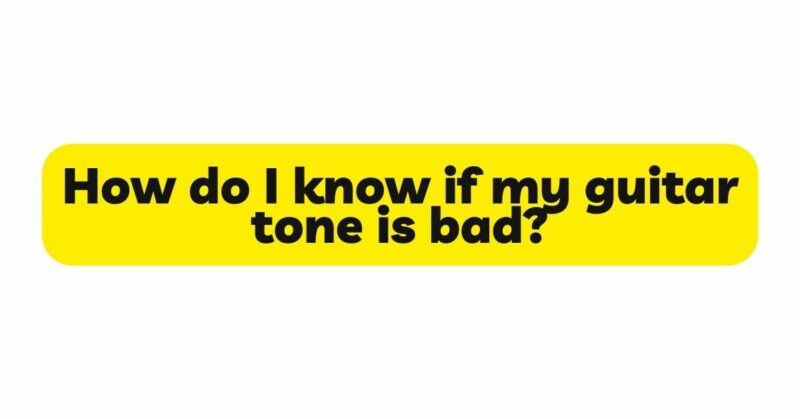Achieving a good guitar tone is essential for every guitarist. It can greatly impact your playing experience, musical expression, and audience engagement. However, it can be challenging to determine whether your guitar tone is bad or if there is room for improvement. In this article, we will explore the key indicators that can help you assess your guitar tone and identify areas for potential enhancement. By understanding these factors and developing a critical ear, you can make informed adjustments to achieve a more satisfying and captivating guitar tone.
- Lack of Clarity and Definition:
One of the primary signs of a bad guitar tone is a lack of clarity and definition in the sound. If your guitar tone sounds muddy or undefined, with notes blending together or lacking distinct separation, it indicates a problem with the overall clarity of your tone. This can be due to various factors such as improper setup, poor intonation, or low-quality pickups.
- Unwanted Noise and Distortion:
Excessive noise, hum, or unwanted distortion can significantly impact the quality of your guitar tone. If you notice an excess of background noise, buzzing, or hissing, it can indicate issues with grounding, poor cable connections, or interference. Additionally, if your tone becomes distorted even at lower volumes or when playing lightly, it may suggest problems with your guitar’s electronics or amplifier settings.
- Lack of Dynamic Range:
A good guitar tone should have a wide dynamic range, allowing you to express different levels of volume and intensity. If your tone lacks dynamics and sounds consistently flat or lifeless, it may indicate compression issues or improper guitar setup. A limited dynamic range can make your playing feel monotonous and rob your performance of expressiveness.
- Poor Sustain:
Sustain refers to the length of time a note or chord resonates after it is played. A bad guitar tone often lacks sustain, with notes dying out quickly and lacking the desired ring and fullness. This can be a result of improper setup, weak pickups, or poor string quality. If your guitar tone lacks sustain, it can make your playing feel disconnected and hinder your ability to create melodic lines or sustain notes for expressive purposes.
- Frequency Imbalance:
An imbalanced frequency response can contribute to a bad guitar tone. If certain frequencies dominate while others are overshadowed, it can result in an unnatural or unpleasant sound. For example, excessive treble can make your tone harsh or piercing, while too much bass can make it boomy or muddy. Evaluating the frequency balance of your tone can help identify areas that need adjustment using equalization (EQ) settings or by adjusting the tone controls on your guitar and amplifier.
- Lack of Articulation and Note Definition:
A good guitar tone should allow for clear articulation and note definition, enabling each note to be heard distinctly. If your tone lacks articulation, with notes blending together or sounding indistinct, it can make your playing feel sloppy or undefined. This can be caused by factors such as high string action, improper picking technique, or inadequate guitar setup.
- Incompatibility with Musical Style or Genre:
The perception of a bad guitar tone can also be subjective, depending on the musical style or genre you’re playing. Different genres have distinct tonal characteristics and expectations. If your guitar tone doesn’t align with the desired sound for a particular style or genre, it may sound bad in that context. Consider listening to recordings of professional guitarists in your desired genre to get a reference for the expected tonal qualities.
- Personal Preference and Satisfaction:
Ultimately, your satisfaction with your guitar tone is subjective and should guide your evaluation. If you find that your guitar tone doesn’t match your personal preferences or doesn’t inspire you, it may be an indication that your tone needs improvement. Trusting your own musical instincts and listening critically to your playing can help you determine if your guitar tone is meeting your expectations.
- Seek Feedback from Others:
Another valuable method for evaluating your guitar tone is to seek feedback from other musicians, guitarists, or trusted listeners. They can provide an objective perspective and point out any noticeable shortcomings or areas for improvement that you might have overlooked. Their input can help you identify specific issues and guide your efforts to refine your guitar tone.
Conclusion:
Assessing whether your guitar tone is bad requires a combination of critical listening, awareness of common indicators, and a consideration of personal preferences and musical context. By evaluating factors such as clarity, noise, dynamic range, sustain, frequency balance, articulation, and personal satisfaction, you can identify areas for improvement and take appropriate actions. Remember that achieving a satisfying guitar tone is a continuous process that involves adjusting various elements, such as guitar setup, electronics, amplification, and technique. Trust your ears, seek feedback, and experiment with different settings and approaches to refine and evolve your guitar tone. With dedication and attention to detail, you can achieve a guitar tone that resonates with your musical vision and brings your playing to life.

